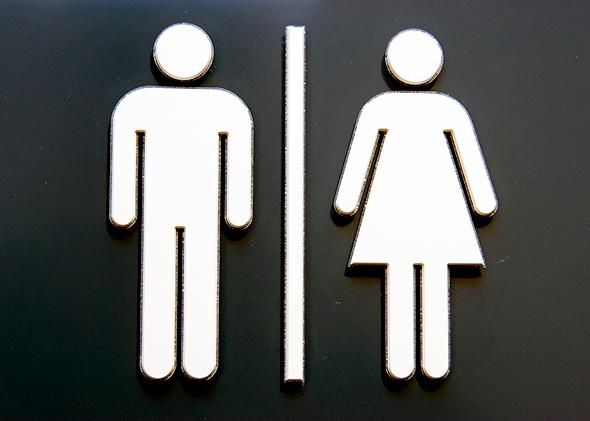It’s easy to think of the push for gender-neutral public restrooms as an issue that matters only to transgender people—after all, they’re the ones left holding their bladders when the stress of constantly using the “wrong” bathroom gets to be too much. But as a straight man, gender-neutral bathrooms matter a lot to me, too—in part because I want the trans community to enjoy the same privileges I do, but also because nothing irks me more than seeing a long line snake out from the women’s room while the men’s room sits vacant, or vice versa. This affront to queuing theory and common sense is never more irksome than when the bathrooms in question serve just one person at a time. In such spaces, the concepts of a “men’s room” and a “women’s room” are completely imaginary; the room belongs to whoever is in it, although that philosophy didn’t impress the two older women waiting for me when I exited “their” one-toilet restroom at a McDonald’s last summer, nor did it stay the manager they’d convinced to escort me Big Mac-lessly to the parking lot.
The world is full of people who agree with my elderly antagonists; most recently they’ve challenged “potty parity” movements at Wesleyan University and Amherst College*, and also in cities like Washington, D.C., which mandated in 2006 that all single-occupancy public bathrooms be labeled as unisex and recently stepped up its enforcement efforts with a Twitter campaign to report violators. Opponents often complain that unisex toilets take facilities away from men and women and hand them over to the transgender minority, when in fact they are available to everyone. Yet the law often takes the narrower view: Many states follow the guidelines laid out in the Uniform Plumbing Code, which stipulates that “separate toilet facilities shall be provided for each sex,” with exceptions for very small businesses as measured in square footage and/or customer traffic. In the eyes of the law in these places, a business with two unisex toilets can be considered to have no toilets at all, since neither facility explicitly serves men or women.
Such laws date back to 1887, according to Terry S. Kogan, a University of Utah law professor and a contributor to the book Toilet: Public Restrooms and the Politics of Sharing. One hundred and twenty-seven years ago, Massachusetts passed the first law mandating gender-segregated toilets, and many states quickly followed suit. Many of those laws have never been substantially modified, with obvious exceptions in progressive enclaves like D.C. and San Francisco, meaning that much of the United States’ toilet-related building codes reflect a literally Victorian prudishness that we might mock in other contexts.
These laws arose due to a confluence of several disparate contemporary movements, Kogan explains in Toilet. The centralization of labor in factories led to the centralization of human waste at work sites, which was carried away by recently developed plumbing technology that had itself been invented in response the newly realized germ theory of disease and the consequent sudden push to improve sanitation. Women’s growing presence in the factory workforce, and in public life more generally, triggered a paternalistic impulse to “protect” women from the full force of the world outside their homes, which manifested itself architecturally in a bizarro parallel world of spaces for women adjacent to but separate from men’s—ladies’ reading rooms at libraries, parlors at department stores, separate entrances at post offices and banks, and their own car on trains, intentionally placed at the very end so that male passengers could chivalrously bear the brunt in the event of a collision. The leap from parlors and reading rooms to ladies-only restrooms was not hard to make, although Kogan admits that “it is not at all obvious what led regulators to conclude that separating factory toilet facilities by sex would protect working women.” His research suggests that sex segregation was seen by regulators at the time as “a kind of cure-all” for the era’s social anxiety about working women.
The laws that still regulate many of our public toilets are simultaneously very old and very new: old in that they were created in an era scarcely recognizable to a modern American, and yet new in that the practice of sex-segregated pooping and peeing as a matter of course is scarcely more than a century old, a tiny fraction of human history. Either way, we must ensure that our public toilets serve everyone before we can wash our hands of them—presumably under a faucet with a motion sensor.
* Correction, March 24, 2016: This piece originally misidentified Amherst College as the University of Massachusetts Amherst.
